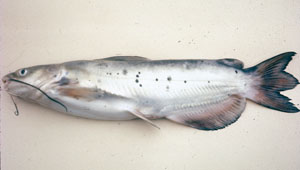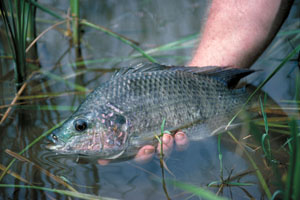Fish
Fish were important resources for native peoples during their stays along rivers and streams in the region. Large fish, such as catfish and gar could be caught on bone hooks, shot with bows and arrows, or speared. Smaller fish in shallow streams could be seined in nets made of plant fiber.
Remains of a variety of species have been found in archeological sites in the region. Catfish (Ictaluridae) and freshwater drum (Aplodintus grunnuiens) were found at both the Hinojosa site in Jim Wells county as well as Site 41LK201 in Live Oak County. Gar (Lepisosteus) also was found at the latter site. Remains of large-mouth bass were unearthed at the Smith Creek bridge site.
There is ample evidence in archeological sites of the consumption of minnow-sized fish. Schools of small fish likely were trapped or netted rather than caught with hook or jabbed with a spear. These fishing strategies were employed at several sites now inundated by the Choke Canyon Reservoir (41MC296, 41MC222, 41LK208) based on the small size of fish bone found there. A variety of small fish (panfish or smaller) were found at deposits at Berger Bluff in Golaid County.
One Spanish explorer’s account notes that south Texas native peoples ate not only the flesh of the fish but ground the bones for consumption. The Mariames of coastal south Texas would roast fish and then dry them in the open air for a week or more. Once rotted and covered with flies and maggots, the flesh was consumed, bugs and all.

Example of a channel catfish, one of several types of the genus found abundantly in South Texas streams and rivers. Photo courtesy Texas Parks and Wildlife Department. |

Remains of long-nosed gar were found at site 41LK201 in Live Oak county. Photo courtesy Texas Parks and Wildlife Department. |
